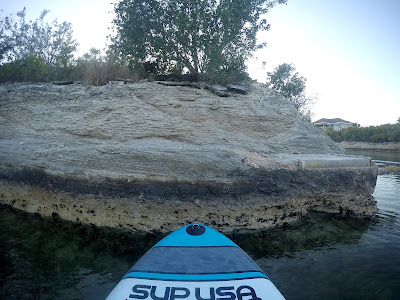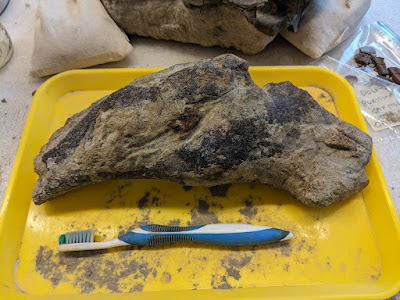This Friday Sarah and I are heading to Playa del Carmen with my family for spring break - since 2018 we've been going to the Caribbean/tropical Atlantic for spring break, since the tropics are so damn close to Charleston and it's pretty affordable* to get to. We've done the Bahamas, Turks and Caicos, and Grand Cayman (twice) and seen some neat stuff. This time, we get to combine the tropical Caribbean with the terrestrial biodiversity of the Yucatan peninsula and the cultural/archaeological heritage of the Mayan civilization - I'm 1/4 Mexican, and while my Spanish is admittedly rudimentary, I love the food, history, and culture and this will be my third time to Mexico since I first went to Baja for Shark Week in 2019 and Mexico City a few months later. The best part about going to Playa del Carmen is the fact that we won't be anywhere near Cancun during spring break and away from all of those college students I have to be around during the school year!
Regardless, I've been meaning to share these photos for quite some time, and since I'm getting excited for our upcoming trip to Mexico, here are a number of snapshots with no particular theme other than showcasing some neat outcrops I paddleboarded by and some various tropical fossils from Turks and Caicos in 2020 and Grand Cayman in 2022. The 2020 photos are taken with a GoPro and aren't great, but the 2022 shots I believe are all with an Olympus TG6 and the photo quality is quite good.
*For our very, very delayed honeymoon (delayed because of my Ph.D.; we wanted to go to Rarotonga in the Cook Islands, just a few hours flight from NZ, but couldn't afford it; after moving to South Carolina it took a few years to scrape anything together owing to how expensive rent is) - we thought about going to the Bahamas, but was uneasy about plane tickets. One day while walking past my colleague's office door I saw a map of Florida and saw that Grand Bahama island is actually on the same map and only like 90 miles offshore - we could probably take a boat! There's a three hour ferry ride to Grand Bahama from Fort Lauderdale and it only costs like 100-150$ per person, round trip. Once there hotels cost ~90-200$ per night. We were able to do five nights and all travel for about 1200$.
A nice afternoon paddle and workout on the canals on the south side of Providenciales in Turks and Caicos - this is taken March 18, 2020 - we were supposed to be enjoying vacation in the tropics but lockdowns started happening across the USA after we left. We flew on a plane weeks before masks were even recommended or the virus thought to be spread through respiratory droplets, unlike SARS-CoV-1. Needless to say our 2020 trip was not the most relaxing. The day we arrived was the first day of panic-buying in grocery stores on the island.
Shortly after venturing out down the canals I noticed these beautiful exposures of cross-bedded oolites - oolites are a type of carbonate sand (oolite) made out of ooids, which are tiny limestone grains that grow through time. Many beautiful white sand beaches in the Bahamas and Turks and Caicos are made of ooids.
It may be difficult to make out here, but this photo shows that the lower part of the section has smaller scale cross-bedding than that above - trough cross-bedding, with individual beds terminating over a distance of 1-2 meters instead of being dominated by laterally extensive, seaward-dipping planar laminations above. Trough cross-bedding suggests subtidal migration of ooidal sand dunes to me, and the planar laminated oolite above is likely instead a beach deposit - the swash zone on the beach itself where the waves go up and down in the intertidal zone. If this is correct then the 3-4 meter sequence here represents shoaling from subtidal to relatively shallower intertidal deposits. I'm not certain whether or not these are early Holocene or Pleistocene sediments. There isn't much published on the sedimentology of this island, which I find surprising.
What a geologist on vacation sees! This is a large cross-bed in the upper unit, showing a bit more complex bedding than normal - there was likely some sort of channel here perhaps. Click on the lower photo to see my annotations and the pattern of bedding. According to some very, very coarse geological maps there are Pleistocene beach deposits along the south side of the island in this area, so perhaps the swash zone of the beach is a reasonable interpretation.
A couple of queen conch shells (Lobatus/Strombus gigas) in ?Pleistocene beach deposits on the north side of Providenciales.
And modern queen conch shells in modern ooidal sand on the south side of Providenciales. Here's a tip for those who want a nice conch shell to bring home (provided the country allows it - which Turks and Caicos does not) - find a seafood restaurant that serves conch fritters (an amazing appetizer in the Caribbean) and go exploring nearby. Frequently, you'll find some piles of shells (and trust me - you'll smell them first, so walk upwind - if you dare!) and will be able to pick out a couple of nice trophies.
A queen conch (Strombus/Lobatus gigas) shell from the Ironshore Formation near Smith's Barcadere in Grand Cayman. I have no idea if collecting such a specimen is legal or not so I left it.
A large brain coral - perhaps Pseudodiploria (symmetrical brain coral), one of the more commonly seen large brain corals in the area today. However, there are certain corals that are completely extinct today in the Caribbean that occur in the Ironshore Formation.
Many transported brain coral fragments mixed together with queen conch shells - under the Dunham classification scheme for limestones, since the large bioclasts are touching, I think this would be classified as a rudstone. None of these corals looked to be in situ.
At the other end of the island we chanced upon another exposure of the Ironshore Formation at Barefoot Beach after our last round of snorkeling on our 2022 trip. I found one of the most interesting fossils of the trip - this fossil Pocillopora, a cauliflower coral! Pocillopora is perhaps one of the most characteristic corals found today in Indo-Pacific reefs - but preserved in the Caribbean during the Pleistocene. Fossils like this one indicate that it became regionally extinct sometime after 125,000 years, which is the age of the Ironshore Formation. Similar specimens dating to the Sangamonian interglacial ~125 Ka have also been reported from rocks of the Dry Tortugas at the southwest end of the Florida Keys.









.JPG)
.JPG)
.JPG)
.JPG)
.JPG)
.JPG)
.JPG)










